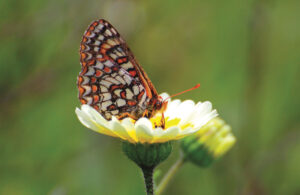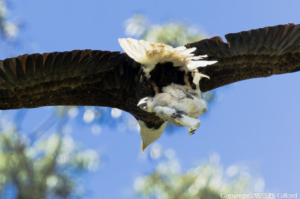The migration route of mountain plovers isn’t well known, but some experts believe that the final leg of their journey could put them in the path of the Montezuma Hills Wind Resource Area near Rio Vista. Ninety percent of the world population of 8,000 to 10,000 individuals winter in California after traveling from their breeding grounds in Montana and Colorado. Near the Bay Area, small flocks can be seen annually in Solano and Yolo counties. Mountain plovers are listed in The American Bird Conservancy Guide to Bird Conservation as one of California’s species of greatest concern. In 1975, their population was around 300,000. Their historical winter grounds once covered California’s Central Valley from Sacramento to Imperial Valley, but suitable habitat has been reduced to patches throughout that range.
To try to find the bird, I headed to the Montezuma Hills with birding expert Robin Leong. We drove on a gravel road through farmland near Highway 12 and Route 113, an area known as wintering territory for mountain plovers. Plovers have been seen there as early as September, but in trying to find them in November, I was reminded of a line in a Gary Snyder poem, “Nature not a book, but a performance.”
The plovers are hard to spot. They’re about as tall as the vegetation in the short-grass prairies they prefer, and they’re rarely seen unless flushed. As we searched, Leong pointed out loggerhead shrikes, meadowlarks, and flocks of lesser goldfinches, small, strikingly beautiful birds that flushed along the fence as we drove, a bit like dolphins riding the bow wave in front of a boat.
On Creed Road, we spotted a large flock of birds in the distance but couldn’t make out the species. They disappeared and reappeared as they banked against the gray sky. “They might be curlews,” said Leong, as they banked south. “Let’s get closer.” What followed wasn’t exactly a high-speed chase, but it came close. Leong put the car in reverse and sped backward until we reached Goose Haven Road. After following the flock to Lambie Road, we watched the birds land in a field full of grazing cattle. Getting out of the car, I unintentionally broke the cardinal rule of birding and slammed the door. Off they flew. Luckily, they circled around and came back to the same field in front of us. Leong got out his scope and pointed it at the flock’s center. He counted 75 birds in the scope’s field of vision. He moved the scope to the left where the flock began, and began counting fields of vision while moving the scope to the right. There were at least 1,000 curlews.
Leong lifted his arms in line with his shoulders, and the curlews spooked again; this time they didn’t return. I’ve yet to see a mountain plover, but I’ll try again this winter. I’m looking forward to whatever performance unfolds. You can track the wintering mountain plovers on the Central Valley Birds message board.

.jpg)



